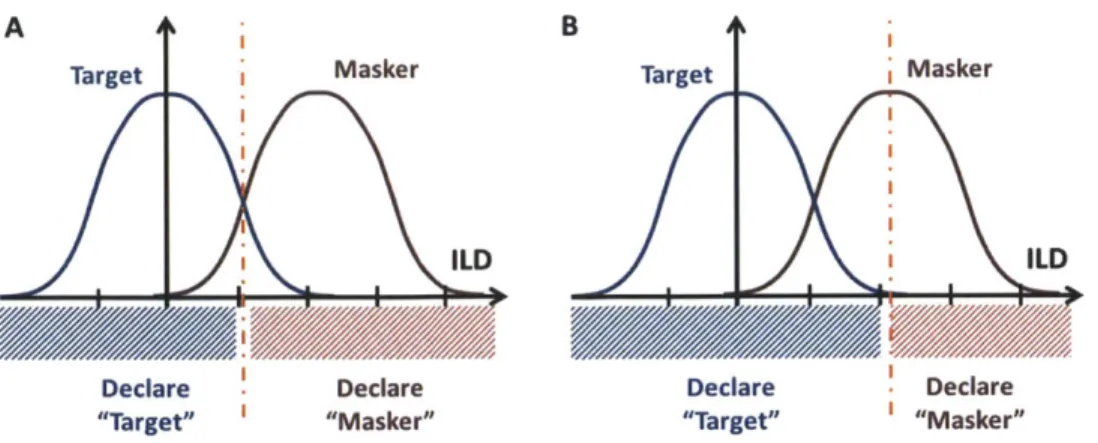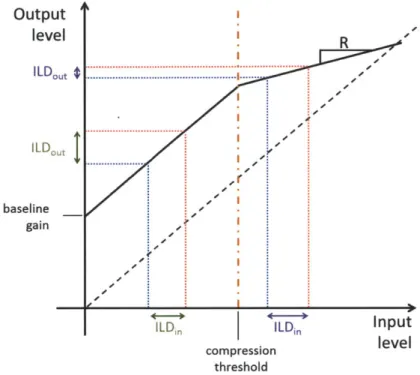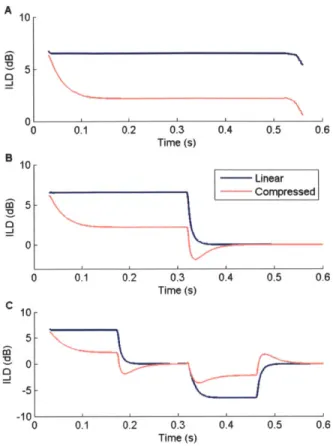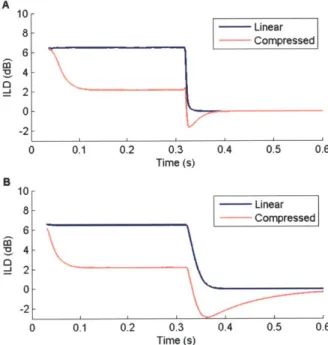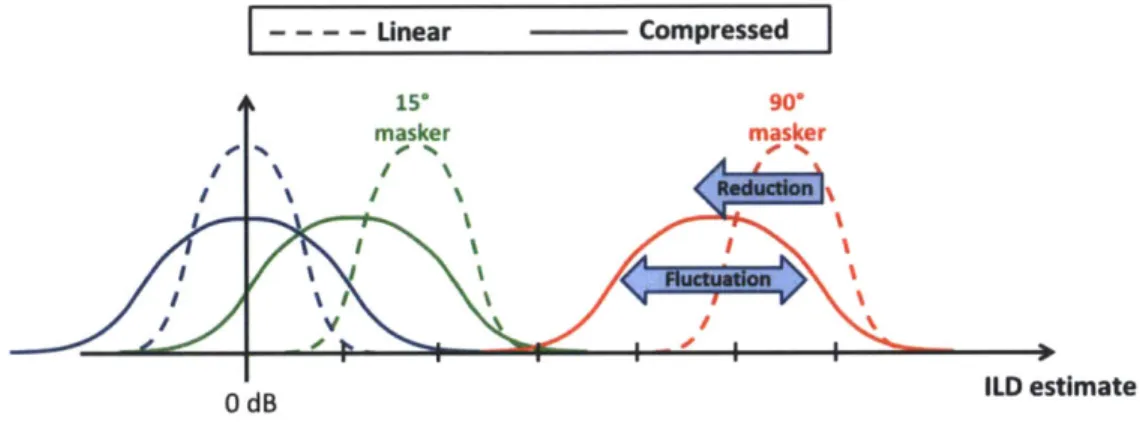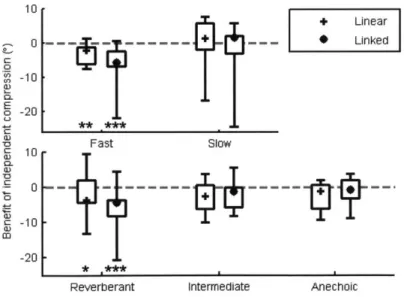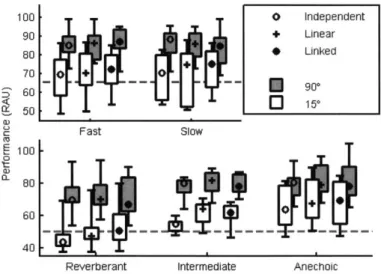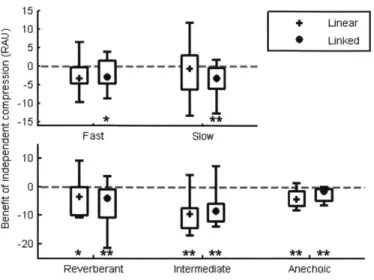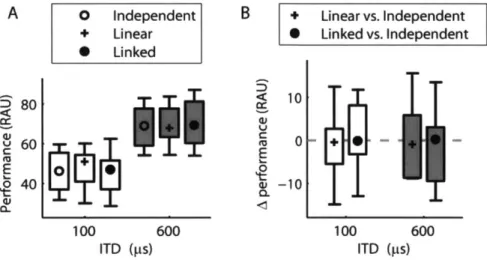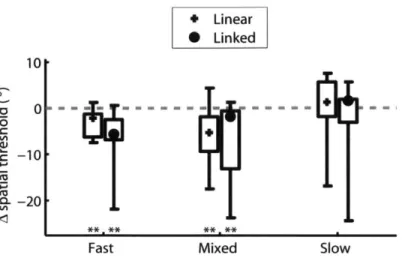Effect of dynamic range compression on attending to sounds based
on spatial location
by
Andrew H. Schwartz
B.S. Computer Systems Engineering Boston University, 2005
S.M. Electrical Engineering and Computer Science Massachusetts Institute of Technology, 2010
SUBMITTED TO THE DEPARTMENT OF HEALTH SCIENCES AND TECHNOLOGY OF THE REQUIREMENTS FOR THE DEGREE OF
ARCHVM_
MASSACHUSETTS INSTITUTE OF TECHNOLOGYSEP
10
2013
LIBRARIES
IN PARTIAL FULFILLMENTDOCTOR OF PHILOSOPHY IN SPEECH AND HEARING, BIOSCIENCE AND TECHNOLOGY AT THE
MASSACHUSETTS INSTITUTE OF TECHNOLOGY SEPTEMBER 2013
©2013 Andrew H. Schwartz. All rights reserved.
The author hereby grants to MIT permission to reproduce and to distribute publicly paper and electronic copies of this thesis document in whole or in part in any medium now known or hereafter created
Signature of Author:
Certified by:
Department of Health Sciences and Technology August 14, 2013
Barbara Shinn Cunningham, PhD Professor, Biomedical Engineering, Boston University Thesis Supervisor
Accepted by:
Emery Brown, MD, PhD PhD/Directo , a/rva rd-MIT Program in Health Sciences and Technology/Professor of Computational Neuroscience and Health Sciences and Technology
Effect of dynamic range compression on attending to sounds based
on spatial location
by
Andrew H. Schwartz
Submitted to the Department of Health Sciences and Technology on August 14, 2013 in Partial Fulfillment of the Requirements for the Degree of Doctor of Philosophy in Speech and Hearing,
Bioscience and Technology
ABSTRACT
Many hearing aids introduce nonlinear compressive gain to accommodate the reduced dynamic range that often accompanies hearing loss. Unfortunately, when applied independently at either ear, this gain can introduce fluctuations in interaural level difference (ILD), which is an important cue for spatial
perception and attending to sounds in an acoustic mixture. Moreover, natural sounds produce complicated interactions between different sounds in a mixture, as a compressor's gain is driven by whichever source dominates the mixture within a specified temporal window. While independent compression can interfere with spatial perception of sound, it does not always interfere with localization
accuracy or speech identification.
This thesis investigates the role of dynamic range compression on the ability to attend to target speech in the presence of interfering speech. First, the fundamental concepts behind dynamic range
compression and its use are introduced, and used to develop a framework to understand some of the possible effects on ILD and spatial perception. This framework is applied toward the interpretation of the existing literature regarding dynamic range compression and spatial perception, bringing together a
seemingly contradictory range of results. In particular, the framework presented here predicts that dynamic range compression will only affect performance in tasks for which relatively small spatial separations are tested, whereas many existing studies compare only large spatial separations to no spatial separation.
We describe and analyze the results of an experiment designed to test this prediction by systematically varying the spatial separation between different speech sources that normal-hearing listeners attended to. We found a robust but modest detrimental effect of dynamic range compression on listeners'
performance. Linking the left and right compressors so that ILD was unaltered restored performance. Lastly, we develop a model to describe the utility of ILD for such tasks. The results of this model provide insight into the reported behavioral results, and generate predictions for how hearing impairment may alter the observed pattern of results.
Thesis Supervisor: Barbara Shinn-Cunningham
I.
Table of Contents
1. Table of Contents...3
11. List o f F ig u re s ... 6
Ill. List of A bbreviations ... 8
Chapter 1 Introduction ... 9
1.1 Auditory scene analysis... 9
1.2 Spatial attention is useful ... 10
1.3 Hearing-im paired listeners suffer from deficits in spatial hearing ... 11
1.4 Dynam ic Range Com pression in hearing aids affects spatial hearing... 12
Chapter 2 Decision Theory Fram ework ... 15
2.1 ILD as a decision variable ... 15
2.2 DRC: Steady-state response ... 18
2.3 DRC: Tem poral dynam ics ... .... 21
2.4 Conceptual m odel of the effect of DRC on ILD discrim inability... 26
Chapter 3 Interpretation of existing literature ... 29
3.1 Spatial attention... 29
3.2 ILD just-noticeable-differences ... 31
3.3 Localization ... 32
3.4 Speech intelligibility in noise... .33
3.6 Predictions for listening experim ents ... 36
Chapter 4 Psychophysical Experim ents ... 38
4.1 Effects of dynamic range compression on spatial selective auditory attention in normal-hearing listeners... ... ... ---...-- - - .39 4.1.1 Abstract...--...--.40 4.1.2 INTRODUCTION ... ... 41 4.1.3 M ETHODS ... . ... 45 4.1.4 RESULTS...53 4.1.5 DISCUSSION ... 61 4.1.6 CONCLUSIO NS ... ... ..---. 66 4.1.7 ACKNOW LEDGEMENTS ... 67
4.2 Dynamic range compression effects spatial selection of speech sounds in normal-hearing listeners... .... ---... 68
4.2.1 ABSTRACT ... 69
4.2.2 INTRODUCTION ... 70
4.2.3 M ETHODS... ...
71
4.2.4 RESULTS... ...-. . 74
4.2.5 DIScUSSION & CONCLUSIONS...76
4.2.6 ACKNOW LEDGEMENTS ... 77
Chapter 5 Auditory M odel ... ... .--81
5.1.1 Auditory periphery... ... .. ... ... 82
5.1.2 Binaural Processing...85
5.1.3 Tem poral weighting ... 87
5.2 Evaluation of m odel perform ance... 90
5.3 Param eter fitting...91
5.3.1 Sensory Noise... 92
5.3.2 M em ory Noise... ... ... 93
5.4 Results: JND paradigm ... 98
5.5 Results: spatial attention paradigm...102
5.5.1 Fast com pression.... ... 103
5.5.2 Slow com pression... 108
5.6 General discussion and sum m ary.... ... 110
Chapter 6 Conclusions ... ... 113
6.1 Thesis overview ... ... 113
6.2 Future w ork...114
II.
List of Figures
Figure 2.1 -Illustration decision rules given hypothetical ILD distributions ... 17
Figure 2.2 - Input-output plot of a simple compression scheme ... 19
Figure 2.3 - ILD of sim ple exam ple stim uli ... 24
Figure 2.4 - ILD traces of example stimuli using a longer release time constant ... 25
Figure 2.5 - Cartoon illustration of possible effects of dynamic range compression on ILD ... 27
Figure 4.1 - Quartiles of subjects' spatial thresholds... 55
Figure 4.2 - Quartiles of within-subject differences of spatial thresholds...55
Figure 4.3 - Quartiles of RAU scores for fixed-azimuth digits with maskers...57
Figure 4.4 - Quartiles of within-subject differences of RAU scores ... 59
Figure 4.5 - Left: Error rates for switch errors and drop errors ... 61
Figure 4.8 - ITD-thresholds in normal-hearing subjects... 75
Figure 4.9 - Perofm rance for fixed-lTD maskers ... 76
Figure 5.1 - Overview of a single band of the peripheral auditory model... 83
Figure 5.2 - Peripheral model parameters as a function of amount of hearing loss ... 84
Figure 5.3 - Overview schematic of the binaural model ... 87
Figure 5.4 - Power-weighting signals for example stimuli ... 88
Figure 5.5 - Source-weighting signals for example stimuli...90
Figure 5.6 - Sensory noise parameter
1
for varying degrees of hearing loss... 92Figure 5.7 - Exam ple ILD histogram s for stim uli at ±70* ... 95
Figure 5.8 - ILD trace for panel B of Figure 5.7... ... 96
Figure 5.9 - ILD histograms for speech mixtures using a model with a flat 40-dB hearing loss. ... 97
Figure 5.11 - Behavioral data from Musa-Shufani and Walgner, 2006...100
Figure 5.12 - JND results for a norm al-hearing m odel...101
Figure 5.13 - Same as Figure 5.12, but with a flat 40 dB hearing loss in the model ... 101
Figure 5.14 - JND results for a hearing impaired model with a larger 3 (by a factor of 2). ... 102
Figure 5.15 - Example model output in the attention simulations ... 104
Figure 5.16 -Model results for spatial attention simulations...106
Figure 5.17 - Effect of bandiwdth on the hea ring-im paired model results ... 107
Figure 5.18 - Spatial attention simulation results using the modified hearing-impaired model...108
III.
List of Abbreviations
CRM: Coordinate response measure HRTF: Head-related transfer function ILD: Interaural level difference ITD: Interaural time difference JND: Just-noticeable difference RAU: rationalize arcsine units
ROC: receiver operating characteristic SPL: sound pressure level
Chapter 1
Introduction
1.1 Auditory scene analysis
In many everyday settings, such as outdoors near a busy street or inside a crowded room, listeners must parse a complex mixture of sound sources into auditory "streams" in order to direct attention to a desired sound source. How the human auditory system accomplishes this remarkable feat has been the subject of ongoing investigation for several decades (Cherry, 1953; Bregman, 1990; Bronkhorst, 2000). To many of us, this task can seem somewhat trivial: for example, at a bar or restaurant, we often focus in on the conversation at our own table with ease, effortlessly ignoring conversations at other tables or even our own table, as well as background music and the cheerful clinking of glasses and silverware. Yet looking at the sheer mathematics of this problem, one cannot help but develop a sense of awe for the sophistication of our auditory system.
Bregman (pp 5-6, 1990) nicely illustrates the difficulty of the problem with the following
gedankenexperiment. Consider a lake, and at the edge of this lake you have dug two small channels. In each of these channels you place a small handkerchief, to be moved by the waves entering the channels.
Now, looking only at the motion of these cloths, you aim to determine all that is occurring on the surface of the lake. How many boats are on the water? How large are they, and how far away? Is the wind blowing? Are the geese on the lake surface? Where are they?
While this task may seem quite impossible, it is in principle exactly the problem our auditory system faces, and solves, on a daily basis. Unfortunately, individuals with hearing impairment often have
accomplish this task. Specifically, we look into the role of spatial separation of sound sources in listeners'
ability to direct attention to a desired sound source. We then investigate how a signal processing
strategy known as "dynamic range compression" (DRC) may affect this ability.
In this chapter, we will build up an understanding of how the normal-functioning auditory system uses
spatial cues to focus attention on a desired source, and describe how hearing loss affects this ability. In
Chapter 2, we discuss some of the current signal processing strategies used by modern hearing aids, and
illustrate ways in which these strategies may in fact be detrimental in some situations. We will more
thoroughly review the existing literature regarding the effects of DRC on several aspects of spatial
hearing in Chapter 3, using our framework from Chapter 2 to interpret a seemingly divergent range of
results. We then test these ideas using behavioral experiments in Chapter 4, and model these results to
produce useful predictions for a broader population in Chapter 5. Finally, we will summarize the
contributions of this work in Chapter 6, discussing its insights and limitations, and outline how future
research could build upon this work.
1.2 Spatial attention is useful
Spatial cues such as interaural level differences and interaural time difference (ILD and ITD, respectively)
arise due to the different paths taken by a sound to reach either ear. These cues allow listeners to
reliably detect changes in a sound's location to angles within as small as 1 degree in the azimuthal plane
(Mills, 1958). For complex sounds such as mixtures of speech, spatial separation between the target and
distracting sources can provide large benefits to a listener's ability to detect and/or attend to the
desired target sound source (Shinn-Cunningham, 2005). There are several mechanisms that allow for
this benefit.
Acoustic head shadow, that is, the attenuation in level of a sound at the far side of the head due to
effect changes the signal-to-noise ratio at either ear, resulting in an improvement that can be as large as
20 dB in some specific stimulus configurations (Zurek, 1993; Shinn-Cunningham et al., 2001). The
neurally represented SNR is likely further enhanced by binaural processing that can take advantage of
ILDs and ITDs in the acoustic mixture (Durlach, 1963; Akeroyd, 2004; Culling, 2007). Some of the largest
benefits of spatial separation on speech understanding, however, have been demonstrated when the
target speech is clearly audible and intelligible but is difficult to distinguish from competing sources,
making it difficult to focus attention on the desired source (Brungart, 2001; Kidd et al., 2005a; Ihlefeld
and Shinn-Cunningham, 2008). In these cases, the spectrotemporal structure of real-world sources such
as speech (including periodicity, spectrotemporal continuity, and common amplitude modulation) first enables listeners to segregate sources from within an acoustic mixture (Carlyon, 2004). Listeners can
then focus attention on the desired source based on higher-level perceptual features such as perceived
location (Shinn-Cunningham and Best, 2008).
1.3 Hearing-impaired listeners suffer from deficits in spatial hearing
Hearing aid wearers often report difficulty following conversations in crowded or noisy environments
(Robillard and Gillain, 1996; Gatehouse and Noble, 2004; Bridges et al., 2012). While this deficit is
related to many issues that occur with hearing loss, such as reduced frequency selectivity and sensitivity
to temporal fine structure of sound waveforms (Hopkins and Moore, 2011), one relevant factor is that in
such situations, hearing-impaired listeners often show a reduced ability to take advantage of spatial
separation compared to normal-hearing listeners (Bronkhorst and Plomp, 1989; Noble et al., 1995; Best
et al., 2011). Providing better amplification to high-frequencies, where ILD is more prominent, has been
shown to improve the benefit of spatial separation in some hearing-impaired listeners (Ahlstrom et al., 2009; Moore et al., 2010).
Unfortunately, as we will see in the following section, current hearing aids often corrupt ILD, and this
effect may limit hearing-impaired listeners' ability to follow speech in crowded or noisy environments.
Methods to enhance spatial cues have been shown to improve localization performance and speech
intelligibility in stationary noise (Francart et al., 2011; Wiggins and Seeber, 2013). Relatively little work
has been done, however, on the effects of such signal processing strategies for attending to speech in
the presence of competing speech, where spatial cues often provide the most benefit. In such
situations, hearing-impaired listeners show a wide range of abilities, with some subjects showing as
good a benefit from spatial separation as normal hearing counterparts to some subjects showing no
benefit of spatial separation whatsoever (Marrone et al., 2008a). Providing a more robust set of spatial
cues to hearing impaired listeners may help these listeners make the most out of a given acoustic
environment.
1.4 Dynamic Range Compression in hearing aids affects spatial hearing
Hearing aids routinely employ a signal processing strategy known as "dynamic range compression"
(DRC). DRC operates by providing greater amplification to signals that have low intensity than to signals
that have higher intensity. For example, a quiet whisper received at an average sound level of 40 dB SPL
may be amplified by 20 dB to an average level of 60 dB SPL so that it is audible, while a loud shout
received at an average level of 80 dB SPL may not be amplified at all. DRC is provided in hearing aids to
alleviate the problem of limited dynamic range available to hearing-impaired listeners, which is often
believed to result from the deterioration of an active, compressive gain mechanism in the inner ear
(Moore, 2007). In some settings, hearing aids that provide DRC can improve speech intelligibility
compared to aids that provide only linear amplification (Moore, 1996; Jenstad et al., 1999).
While the benefit of bilateral vs. unilateral hearing aids has been known for decades (Markides, 1982;
of one another. Unfortunately, when DRC is applied independently to both ears, it can alter the ILD
present in the acoustic signal. When a sound has some non-zero ILD, it is relatively more intense in one
ear vs. the other. Due to the nature of DRC, the less-intense signal will be amplified relatively more than
the more-intense signal, leading to a reduction in ILD. For several reasons, it is not immediately clear
how compression will affect the spatial perception of sounds. Human listeners have a remarkable ability
to adapt to statically altered interaural cues (Bauer, 1966; Simon and Aleksandrovsky, 1997;
Shinn-Cunningham et al., 1998), and therefore the changes in ILD caused by DRC may not be perceptually
meaningful to a listener after some period of acclimatization. However, DRC in hearing aids does not uniformly reduce the ILD even within a single acoustic stimulus, as we will see in detail in the following
chapter. Complicating this picture further is the fact that DRC schemes in hearing aids can take
anywhere between a few milliseconds and several seconds to respond to a new stimulus level (see:
Moore, 2008). As a result, the effects of DRC on ILD are not as simple as a static reduction. Instead, the
change to ILD will be temporally variable and dependent on the timing between different sound sources
in a mixture. We will explore the effect of dynamic fluctuations to ILD in more depth in later chapters.
Among the existing studies that examine the effect of DRC on spatial aspects of hearing, an interesting
mix of results can be found. With DRC, both normal-hearing and hearing-impaired listeners required
larger differences in ILD between two otherwise identical stimuli to be able to distinguish them apart
from one another (Musa-Shufani et al., 2006). Subjectively, DRC can also lead to effects such as more
broad or diffuse sound images, illusory movement, and split sound images (Wiggins and Seeber, 2011,
2012). However, studies often find no effect of DRC on localization accuracy (Keidser et al., 2006;
Musa-Shufani et al., 2006). The effect of DRC on the spatial benefit of spatial separation of speech from
stationary noise is unclear (c.f. Moore et al., 1992; Wiggins and Seeber, 2013), and a similarly confusing mix of results can be found for speech with interfering speech (c.f. Kalluri and Edwards, 2007; Marrone
In this thesis, we attempt to reconcile this variety of results found in the literature by looking in detail at
how DRC can affect acoustic spatial cues, and how such effects may influence spatial perception in a
variety of situations. We will build a framework that allows us to interpret these existing results in a
consistent manner. Here we are primarily interested in the influence of DRC on a listener's ability to
attend to speech in the presence of interfering speech, a situation which repeatedly emerges as one of
the chief complaints of hearing-aid users (Kochkin, 2010, 2011). We will therefore design an experiment
aimed at testing this framework in a manner relevant to this common type of acoustic setting. As a first
study of these effects, we will only perform this experiment with normal-hearing listeners. Therefore, we will develop a binaural auditory model from existing components to replicate the trends observed in
our experiments and to generate predictions for hearing-impaired listeners using typical DRC in hearing
Chapter 2
Decision Theory Framework
2.1 ILD as a decision variable
In this chapter we will build a more detailed understanding of how DRC affects binaural acoustic signals. We will describe a simple but common DRC strategy, and describe its effects on the ILD of sounds. In this thesis, we are focused on the utility of ILD on selective attention tasks, such as attending to one voice in a crowd, rather than on localization per se. While these two tasks are intuitively related, good
performance in either of these tasks does not imply good performance in the other (Gallun et al., 2008; Schwartz et al., 2012). Therefore it will be important to keep the distinction between localization and spatial attention in mind as we develop our understanding of this complex issue, and as we interpret the results presented in Chapters 3-5. This distinction will be further illustrated as we develop examples in this chapter.
The view we take is that the auditory system uses "bottom-up" grouping cues to extract perceptual sound "objects" from an acoustic mixture; it then uses higher level features such as perceived spatial location to direct attention toward relevant sound objects (Shinn-Cunningham and Best, 2008). We are primarily interested in the latter process; that is, the utility of spatial cues such as ILD to determine if a specific token of sound belongs to the target of attention or not. With this view, spatial cues need only bear differences sufficient to tell two or more sound sources apart; they need not necessarily accurately identify the sources' physical locations. While multiple cues, including non-spatial cues, can generally contribute to this distinction, here we focus simply on the utility of the ILD cue by itself. The role of ILD may be somewhat redundant in certain situations where other cues are sufficient to distinguish the
sources in a mixture (e.g., Helfer and Freyman, 2008; Marrone et al., 2008b), but the presence and
strength of any of these cues can depend largely on the stimuli and the environment. It is therefore
useful to understand the role of ILD specifically, and how DRC may affect that role.
To address this question, we will treat ILD as a decision variable used to estimate if the target sound is
present or not at any given instant. This type of problem is well-studied in decision theory, allowing us
to use tools from this discipline to quantify the effect of DRC. While we will provide much more concrete
data to this effect in our auditory model in Chapter 5, it suffices for now to describe this essential
problem in more general terms as follows. We will describe the ILD associated with a specific frequency
band of the target source and one or more interfering sources by a distribution of values, as illustrated
in Figure 2.1, computed over any time window in which the sources are assumed to not be moving. This
distribution can represent either a parametric probability distribution modeled from observations or a
non-parametric summary of those observations. Given this set up, we can define a decision rule by
partitioning the space of observable ILD values into two or more regions, each of which is associated
with either the target or the masking sources. When a sound element's ILD is determined to lie in the
region associated with the target, the decision rule declares that this sound object containing this
element belongs to the target source. Note that other features, such as vocal identity and even ILD in
other frequency bands, could provide additional or even conflicting information; in general, no single
feature is a perfect predictor of a sounds source's identity. It is beyond the scope of this thesis, however,
to consider the combination of such conflicting pieces of information. Instead, we focus solely on how
A B
Target Masker Target Masker
ILD ILD
Declare Declare Declare Declare
"Target" "Masker" "Target" "Masker"
Figure 2.1 - Illustration of two of infinitely many possible decision rules given identical ILD distributions of the target (blue) and masker (red). These two rules illustrate the trade-off between two different types of error, dubbed "false alarm" and "miss" errors. A: This rule equally weights both error types: the probability of incorrectly declaring "target" equals the probability of incorrectly declaring "masker". B: This rule has almost no probability of incorrectly declaring "masker", as the masker decision region (red) contains virtually no probability mass from the target ILD distribution. However, this rule has a rather high probability of incorrectly declaring "target", as the target decision region contains a significant portion of the masker probability distribution mass.
We will apply more formal techniques to this type of formulation in Chapter 5; for now, however, it
suffices to say that the utility of ILD to distinguish between the target and masker is inversely related to
how much these two distributions overlap. If there is no overlap, then the decision regions for the target
and masker can cover all areas where the corresponding distribution has non-zero probability, and ILD
can be used to uniquely determine which source generated a given sound. This is not realistic, and in
general these distributions will overlap by some amount. This overlap can be due to acoustic factors,
such as reverberation and the frequency-dependence of ILD, as well as neural factors limiting the
precision of any neural representation of these distributions. As the overlap increases, we can say that
ILD is becoming less useful for determining which source a particular sound belongs to. When there is
full overlap (i.e., when the target and masker distributions are identical), then using ILD to distinguish
Notice that the overlap between two distributions is determined by the relative location of the peaks as
well as the widths of the distributions, and is independent of the absolute position of the center of
either distribution given these two measurements. Thus this framework is ideal for describing the
discriminability between two stimuli rather than the location of either. Localizing these stimuli would
instead be accomplished by, for example, estimating the mean of either distribution and mapping the
resulting ILD value to a corresponding physical location. We will however not directly address the
question of localization in this thesis, focusing instead on the use of spatial cues to direct attention
toward a target sound source.
2.2 DRC: Steady-state response
Now that we have defined our problem setup, we can begin to assess the effects of DRC on the
discriminability of sounds by ILD. There are many varieties of DRC algorithms used in hearing aids and
other audio applications, but they all largely share a common feature: a simple compression scheme will
apply linear gain below some set threshold, and will provide progressively less gain as the input signal
increases in level beyond this threshold. Such a compression scheme is illustrated in Figure 2.2. The
amount of gain applied with increasing input levels is determined by the compression ratio R; the
compressor aims to increase the output signal level by 1 dB for every R dB increase in the input signal
level. Thresholds on compressors designed for speech intelligibility are often set to be around the level
of relatively quiet speech, but can vary from user to user. Typical values of R for hearing aids range from
just above 1 (almost linear) to roughly 3 for more severe cases of hearing loss. Commonly added
features to compression schemes include a sharp roll-off for very low levels so as not to over-amplify
ambient background noise and microphone noise, a return to linear gain for high levels to avoid
providing negative gain to high-level sounds, and a hard-limiter for very high levels to prevent
simple compression scheme defined by a linear gain, compression threshold, and compression ratio (as
well as temporal dynamics; see Sec.2.3).
Output level I LD0O~t
1LDOUt
f . .
baseline _ gainILD ILDi Input
compression level
threshold
Figure 2.2 - Input-output plot of a simple compression scheme, represented by the solid black line, for arbitrary decibel values. The dot-dash line shows the compression threshold. For input levels below this threshold, sounds are linearly amplified: constant gain in decibels is applied. Above this threshold, a compression ratio of R is applied: every increase of R dB in the input results in a 1 dB increase in the output level. Red and blue dotted lines represent the right and left inputs, respectively, of two example stimuli at different overall levels. These two examples have the same input ILD (represented by distance between the red and blue lines on the x-axis, labeled "lLDin"), but only the stimulus whose level is above the compression threshold has a reduced output ILD (distance between the red and blue lines along the y-axis, , labeled "lLDout").
As illustrated by Figure 2.2, when a binaural sound is compressed by this type of processing operating
independently on both left and right-ear signals, its ILD can be reduced by up to a factor of R (the
compression ratio). Thus the steady-state response of bilaterally-independent DRC is to reduce the ILD
of most sounds in a listener's environment, bringing sounds closer together along this perceptually relevant dimension. There are at least two reasons why the overall reduction of ILD might greatly not
at adapting to modified interaural cues; such adaptation can be shown in behavioral responses (Bauer,
1966; Shinn-Cunningham et al., 1998) as well as on a neural level (Kacelnik et al., 2006; Dahmen et al., 2010). If hearing aids were to universally reduce ILD, listeners wearing those aids would likely to be able
to learn the mapping of the altered ILDs to physical locations. However, this reduction in ILD occurs only
for sounds above the compression threshold, and it is unknown how well listeners could adapt to a
level-dependent change in ILD.
Even if listeners are able to adapt to modified ILD, we should still expect a reduced ability to
discriminate between two ILD values that are very close to each other. Going back to our decision theory
setup of Figure 2.1, let us assume for a moment that some part of the width of the ILD distribution is
due to internal noise or precision limits of the underlying neural system (e.g., Durlach and Braida, 1969;
Searle et al., 1976) and that this component of neural noise cannot be altered by external stimulus
processing. Now imagine two sounds whose respective ILDs are just barely distinguishable due to this
noise. When those ILDs are reduced by DRC, then those two sounds will cease to be distinguishable by
ILD. This fundamental argument applies regardless of an individual's ability to adapt to a new mapping
of ILDs to physical locations in space.
Another argument for why this reduction might not affect spatial perception is specific to
hearing-impaired listeners: if the mechanism of hearing loss reduces compressive gain in the inner ear, ILD will
be expanded, and hearing aid DRC should approximately restore "normal" ILD values. Due to the varied and complicated nature of hearing loss and the practicalities of hearing aid devices, this restoration can
only be approximate; nevertheless, on a more practical note we need simply to point out that the same
argument as stated in the preceding paragraph applies. That is, for ILDs that are just distinguishable
from neural noise, a reduction of those ILDs will render them indistinguishable regardless of whether or
not that reduction can be said to be restoring normal neural ILDs. Moreover, despite any expansion of
sensitivity compared to normal-hearing listeners (Florentine et al., 1993; Koehnke et al., 1995; Musa-Shufani et al., 2006), and compression indeed degrades this sensitivity (Musa-Musa-Shufani et al., 2006).
A further complication to our increasingly complicated picture is that DRC will not uniformly reduce ILDs in any stimulus or mixture of stimuli. Even when a target sound source is presented alone, fluctuations
in its level interacting with a given DRC scheme can cause fluctuations in ILD, and these fluctuations are
likely the cause of perceived movement, diffuseness, and splitting of ordinarily stationary sounds for
normal-hearing listeners (Wiggins and Seeber, 2011, 2012). When interfering sources are also present,
the mixture of both stimuli can cause the compressors to affect ILD differently than when the target is
presented alone. Here, the fluctuations to ILD can become unpredictable and not directly related to the
target. Therefore, experiments that investigate the effect of DRC on isolated stimuli (e.g., Keidser et al.,
2006; Musa-Shufani and Walger, 2006; Wiggins and Seeber, 2012), or even stimuli with stationary noise (e.g., Moore et al., 1992; Wiggins and Seeber, 2013) may underestimate the effect of DRC compared to
what may be revealed when multiple, dynamic stimuli are present, such as in a speech mixture.
2.3 DRC: Temporal dynamics
Fluctuations in ILD due to fluctuations in a stimulus' level and in the level of interfering stimuli are still
only a part of the story. Another factor of hearing aid DRC that may dramatically influence its effect on
spatial perception comes from its temporally-varying response. As mentioned above, naturally occurring
sounds, such as speech, fluctuate in level from moment to moment. These fluctuations are important to
speech intelligibility (Elhilali et al., 2003). If DRC were to act instantaneously or nearly instantaneously,
these modulations could easily become severely corrupted and speech intelligibility can suffer as a
result (Stone and Moore, 2004). Furthermore, instantaneous compression would distort the
fine-structure of an acoustic waveform, introducing significant harmonic distortion. To avoid these
"release" time constants (ANSI, 2003) on the order of milliseconds to seconds. The attack and release
time constants determine how quickly the gain of the compressors changes in response to a sudden rise
or drop, respectively, in the input signal level.
These temporal dynamics add another dimension of complexity to the nature of DRC-imposed ILD
fluctuations. Some examples of this are illustrated in Figure 2.3, using an attack and release time
constant of 40 ms. In panel A, the ILD at the onset of an isolated tone burst is unaffected by DRC.
Because localization is dominated by spatial cues near stimulus onsets (Freyman et al., 1997; Stecker
and Hafter, 2002), localization may be relatively unaffected by compression in such simple conditions,
consistent with the previous reports of a lack of effect of compression on localization of isolated stimuli
in quiet, anechoic environments (Keidser et al., 2006; Musa-Shufani et al., 2006).
In panel B, a tone burst from center follows a tone burst from the right. As in panel A, the source from
the right has a "clean" onset ILD. The source from the center, however, has an ILD at its onset that is
pushed farther left (negative ILD) when DRC is applied compared to when it is not. At the onset of this
second stimulus, the compressors are still applying gain according to the input levels of the first
stimulus; that is, they are applying a negative bias to the ILD. Therefore, for some time following the
onset of the second stimulus, the ILD at the output of the compressors will be negatively biased
regardless of the ILD at their input. While this effect may impair localization of the second stimulus, we
note that the onset ILDs are actually farther apart with DRC than without. Thus, if we assume that
discriminating between two source locations is in fact heavily influenced by stimulus onsets, as
localization of single sources is, then it is plausible that DRC in this situation can actually enhance the
perceptual distinction between these two stimuli, actually improving a listener's ability to discriminate
between them. This situation again highlights the difference between DRC's possible effects on
discriminating between different sound sources versus localizing them. Notice that the linear ILD trace
to influence the power estimate used to compute ILD for a short period of time, which is computed over a 20 ms window (for more details on how ILD is computed here, see Section 5.1.2).
Finally, in panel C, we add more source locations: a source from the right is followed by a source from
center, in turn followed by a source from the left, and finally the source from center again. The blue line,
representing the uncompressed ILD, can be followed to determine which source is active at any given
time on the plot. Here we can see that the ILD at the onset of the source from center (where the blue
line goes to zero) is pushed in either direction by DRC (pink line), depending on the stimulus that
preceded it. Even in this simple example it becomes difficult to use the compressed ILD plot alone to
distinguish between the various sources locations. In more realistic settings, with any number of
potentially overlapping stimuli, each with varying levels and more varied timing, the effects on ILD can
A 10- 5-01 0 0.1 0.2 0.3 0.4 0.5 0.6 Time (s) B 10 - Linear Compressed 0 0 0.1 0.2 0.3 0.4 0.5 0.6 Time (s) C 10- 5-0 0- -5--10, 0 0.1 0.2 0.3 0.4 0.5 0.6 Time (s)
Figure 2.3 - ILD of simple example stimuli, under linear processing and
bilaterally-independent dynamic range compression. In each panel, the stimulus begins after a 10 ms silence to avoid edge effects in the compressor's smoothing operation. A: Isolated tone burst at 70*. B: Tone burst from 700 followed immediately by a tone burst from center. B: Tone burst from 70, center, -700, then center again. ILD was computed using power estimates in a 10-ms exponential window, resulting in brief dynamic transitions even in the linear processing case.
Generalizing from these observations, we say that the bias in ILD applied to one stimulus will be applied
for some time to the onset of a stimulus that immediately follows it. Lest the reader suspect that the
story ends here, we further point out that how long the compressors take to adjust to the new stimulus
depends on an interaction between the compression attack and release time constants and the level of
both stimuli. This dependence is illustrated in Figure 2.4. In both panels, a stimulus from the right is
followed by a stimulus from the center, and the compressor is set to have an attack time of 10 ms and a
stimuli. In panel A, the right stimulus is set to 50 dB SPL', while the center stimulus is set to 70 dB SPL.
Because the level of the center stimulus is greater in both left and right ears than the level of the initial
stimulus, the attack time is applied, and the ILD adjusts quickly to the steady-state value of the second
stimulus' compressed ILD. In panel B, the levels of the two stimuli are reversed. Here, because the level
of the second stimulus is now lower in both left and right ears, the longer release time applies, and the
ILD takes longer to adjust.
A 10-8 - Linear Compressed 2-0 -2 0 0.1 0.2 0.3 0.4 0.5 0.6 Time (s) 10 8 - LinearCompressed 6 42.4 0--2. 0 0.1 0.2 0.3 0.4 0.5 0.6 Time (s)
Figure 2.4 - ILD traces of example stimuli using a longer release time constant (100 ms) than attack time constant (10 ms). In panel A, the initial right stimulus has a level of 50 dB SPL, and the second center stimulus has a level of 70 dB SPL. In panel B, these levels are reversed. The profound difference in the pink trace, representing the compressed ILD, even 100 ms after the transition, is due to the attack time applying to the transition in panel A but the release time applying in panel B due to the differences in stimulus level.
2.4 Conceptual model of the effect of DRC on ILD discriminability
With the examples presented in the previous section it is becomes evident that the exact effects of DRC on ILD can quickly become quite complicated and mathematically intractable. Therefore, as a conceptual simplification to allow some principled analysis and exploration of the effects of DRC on the ILD of mixtures of multiple, dynamic stimuli, we consider the following big-picture effects of DRC on ILD: (1) overall, steady-state ILD reduction, and (2) ILD fluctuation, caused by the dynamics both within stimuli as well as in the compression parameters. In particular, as we saw illustrated in Figure 2.3, the
fluctuations in ILD due to DRC can bias ILD in any direction, even if the uncompressed ILD is zero!
Building on this construct, we develop a simple, conceptual model of how we expect DRC to affect the utility of ILD in such tasks as attending to target speech in a mixture. Returning to our decision theory setup, we assume we have an ILD distribution associated with the target stimulus and another associated with one or more masking stimuli. The mean location of these distributions will be
determined by the physical locations of the corresponding stimuli. The width of these distributions will depend on internal noise related to the representation of ILD as well as fluctuations in ILD over time. We are interested in modeling the effects of ILD reduction and ILD fluctuations caused by DRC.
ILD reduction will in general bring the mean of these distributions toward zero. It can also reduce ILD fluctuations present in the acoustic stimulus itself. However, reduction of ILD might not reduce internal noise, and therefore the net result of moving the ILD distributions closer to zero can be an increase in their overlap. As we saw in the previous section, ILD fluctuations can occur in any direction regardless of the unaltered source ILD, so we describe these additional ILD fluctuations by an increase in the
distribution width. This effect will further increase the overlap between target and non-target ILD distributions. These possible effects are illustrated in Figure 2.5.
Notice that the ILD distributions of the blue target at center and the red masker from 90" have
practically no overlap with or without the effects of DRC. Thus, in this case, the conceptual model
predicts no effect of DRC on the discriminability of these two sources: the distributions are sufficiently
distinct such that they are robust to the modest degradation illustrated here. The green distribution for
the 15" masker, however, overlaps that of the target substantially more with DRC than without; the
conceptual model therefore predicts that for stimuli that are "sufficiently close", as these stimuli are,
DRC will result in impaired discriminability.
- - -- Linear Compressed
150 900
masker masker
0dB ILD estimate
Figure 2.5 - Cartoon illustration of possible effects of dynamic range compression on ILD distributions for three sources. Dashed lines represent ILD distributions prior to DRC, solid lines represent distributions after DRC is applied. (1) Blue: a target source from center, with mean 0 ILD. (2) Red: a masker from far right (90"). (3) Green: a masker from an intermediate location (150). Arrows mark the two groups of effects: ILD reduction and ILD fluctuations. Reduction brings distribution means closer to zero, while fluctuations result in wider distributions (even for sources with zero mean ILD).
Figure 2.5 illustrates that bilaterally independent DRC may impair the ability to attend to a source in an
acoustic mixture in some, but not all, situations. Specifically, when sources are far enough apart in space
such that the illustrated effects on ILD do not result in any notable increase in the overlap between two
ILD distributions (e.g., blue and red distributions in Figure 2.5), then the ability to attend to either source
based on ILD is unlikely to be affected by this corruption. This insight highlights an important design consideration for experiments that investigate the effect of DRC in real-world settings. Many studies
quantify the benefit of spatial cues by comparing performance in some selective attention task when
stimuli are collocated vs. separated by a large angle, such as 90* (e.g., Marrone et al., 2008a). However,
our conceptual model shows that performance with large separations is unlikely to be affected by DRC,
but that performance might be affected for smaller target-masker separations. Therefore, the choice of
studying only large separations can lead to the erroneous conclusion that DRC has no impact on spatial
Chapter 3
Interpretation of existing literature
In this chapter, we present a thorough review of the existing literature that deals with the effects of DRC
on spatial hearing. We show that this conceptual framework of Chapter 2 can explain the variety of
results found in the literature despite their apparent conflicting interpretations.
3.1 Spatial attention
Of primary interest in this thesis is the effect of DRC on a listener's ability to attend to a target speaker in the presence of competing speech. Two studies address this issue directly, measuring the benefit of
spatial separation in terms of a reduction in the SNR required to successfully attend to a target when
maskers were spatially separated from the target compared to when they were collocated with the
target. One of these studies showed evidence of a detrimental effect of DRC for normal-hearing listeners
when ILD was the only available spatial cue (Kalluri and Edwards, 2007). There was little to no effect
when ITD was also available. Oddly, hearing-impaired listeners in the study demonstrated no benefit of
spatial separation at all, and were therefore not tested with compressive amplification. In the other
study, there was no effect of compressive amplification for hearing-impaired listeners (Marrone et al.,
2008a). A caveat to this latter study is that the comparison was made between aided and unaided (but
equal sensation level) listening, so effects due to DRC cannot be decoupled from effects due to other
device-related factors such as frequency shaping and microphone sensitivity. For instance, speech may
have been more intelligible due to better frequency shaping with the hearing aid devices, counteracting
The results of both of these studies should be interpreted carefully. Both used speech material from the
Coordinate Response Measure corpus (CRM; Bolia et al., 2000). This corpus contains sentence
exclusively of the form "Ready [callsign] go to [color] [number] now." Unfortunately, as a result, when
multiple sentences from this corpus are used simultaneously, the individual words will exhibit an
unnaturally high degree of temporal overlap. Such a situation is known to limit the benefit of spatial
cues, particularly for hearing-impaired listeners (Best et al., 2011). Therefore, any potential effect of DRC
may have been masked by the inability of listeners to use spatial cues as effectively as might have been
possible had less constrained, running speech been used. Consistent with this concern, hearing-impaired
listeners in the study of Marrone et al. showed an average of only 3 dB benefit of spatial separation, and
hearing-impaired listeners in the study of Kalluri and Edwards showed no benefit at all. By comparison,
studies using either other speech corpora or signal processing aimed at reducing the spectrotemporal
overlap between target and masker speech often show average benefits between 6 dB and 10 dB for
hearing-impaired listeners (Arbogast et al., 2005; Neher et al., 2009, 2011).
Another concern with the high degree of temporal synchrony between sentences using the CRM corpus
specifically involves the nature of bilaterally independent DRC and the fact that these studies placed
maskers symmetrically flanking the target (i.e., with equal but opposite azimuths or ILDs). If two
symmetrically placed maskers are active simultaneously in a particular frequency band, then the level at
the input of the left and right compressors will be approximately equal, and therefore there will be no
effect on ILD. Due to differences in the words spoken by each talker, there may still be some differences
in level at different frequencies, but it is nevertheless likely that this situation does not fully represent
the range of real-world signals experienced by listeners. Kalluri and Edwards addressed this artificial
symmetry by attenuating one of the maskers by 6 dB; still, the net effect here compared to equal-level
the target and maskers should be roughly independent, which it likely to increase the effect of DRC on
ILD.
A final concern with the study of Marrone et al. is that spatial benefit was only measured for maskers located at ±900. As illustrated in Figure 2.5, this scenario may underestimate the practical consequence
of DRC on spatial hearing relevant to everyday listening. While the limited benefit of spatial separation
shown in this study may have necessitated this large separation, it is possible that using less constrained
stimuli such as running speech would have allowed for a larger benefit even at smaller angles, which
might reveal an effect of DRC.
3.2 ILD just-noticeable-differences
DRC can lead to a large increase (worsening) in just-noticeable-differences (JNDs) for ILD (Musa-Shufani
et al., 2006) of narrow-band noise bursts. That is, DRC leads to an increase in the amount by which the
ILD of two stimuli must differ in order for listeners to reliably tell them apart. This is perfectly consistent
with our central argument: when two stimuli are "sufficiently close" in ILD, such as when they are
just-noticeably different, then DRC will impair a listener's ability to discriminate between them based on ILD.
This effect, however, was limited to when compression employed fast time constants. This observation
suggests that listeners were able to use the uncompressed ILD at the stimulus onsets to improve their
performance when the time constant was long. Even when the attack time was as short as 2 ms, JNDs
were increased by less than the compression ratio (either 3:1 or 8:1), implying that even a very short
onset ILD can be useful. While Musa-Shufani and Walgner did not perform pair-wise tests for each
attack time, the data suggest that there may still be an effect with longer attack times. If this effect is
real, it implies that despite having access to the cleaner onset ILD, listeners were still unable to
3.3 Localization
Despite the effect on JND, in some situations, DRC has no effect on localization accuracy of narrow-band
or wide-band noise bursts (Keidser et al., 2006; Musa-Shufani et al., 2006). One study did show that
compressive amplification increased localization errors of various broadband stimuli, including noise
bursts and a telephone ring (Van den Bogaert et al., 2006); but, as we noted with the speech masking
experiment of Marrone et al., it was not DRC per se that was studied but compressive amplification vs.
unaided performance.
There are several reasons why the first two studies may have shown no effect of DRC on localization
accuracy. First, the spatial separations between loudspeaker locations used in these experiment, and
therefore the minimum azimuthal difference between different stimuli, were 150 or 180 respectively, at
least an order of magnitude greater than listeners' average JNDs for azimuthal separation. It is possible,
then, that the stimuli presented were not "sufficiently close" to affect the correct identification of the
sound source locations used; the effect of DRC might be so small as to only matter for the smallest of
spatial separations or under special conditions (the study by Van den Bogaert et al. also used spatial
separations of 15" and did find an effect). However, there are still some more considerations when
interpreting these results.
One of the most important reasons why DRC might not have had a significant impact on localization
performance in the first two studies is that these experiments used stationary stimuli in quiet
environments without distracting sound sources. By contrast, the study performed by Van den Bogaert
et al. included localizing a telephone ring in the presence of speech babble. Keidser et al. used one
condition with stationary background noise, but unfortunately did not include a comparison of DRC with linear amplification in this condition. From our framework above, then, we have two reasons to suspect
the onset ILD will have been unaltered between linear and compressed conditions, and as we have seen
with the JND experiments of Musa-Shufani et al., this onset ILD can play a crucial role in performance.
The second is that fluctuations in the target level as well as the addition of interfering stimuli results in
the compressors having more complicated effects on ILD. Neither of these effects was present in the
stimuli used in these two studies.
3.4 Speech intelligibility in noise
One study objectively measured speech intelligibility by hearing-impaired listeners in pseudo-stationary
noise (Moore et al., 1992). By pseudo-stationary noise, we refer to 24-talker babble; the benefit of
spatial separation for speech on speech masking diminishes as the number of interfering talkers
increases beyond 2, and this effect appears to be due to the fact that a mixture of interfering talkers
becomes more similar to stationary noise as the number of independent sources increases (Freyman et
al., 2004). In this case the action of the compressors due to the maskers will be nearly stationary as well,
limiting its effect on the variations in the ILD of the target. This pseudo-stationarity was particularly
relevant to the hearing aid used in this experiment because the compressors operated only on two
independent frequency channels. Using two relatively wide channels makes it highly likely that a given
channel will be receiving energy from several of the 24 independent speech utterances at any given
time, resulting in relatively stationary behavior over time. Additionally, for the babble to be a
comparable level to the target speech, the level of each individual talker in the babble had to be low so
as to be not easily confused with the target, resulting in a target that was much louder than, and
therefore perceptually very distinct from, each talker in the babble. This perceptual distinction reduces
the need for cues such as ILD in order to distinguish between the target and masking speech (Brungart,
and 12 talkers in the left speaker at -90*, which we have argued may not be an ideal setup to test the effect of DRC on spatial perception.
In a more recent study involving normal-hearing listeners, DRC was shown to have a detrimental effect
on speech intelligibility in stationary noise that was separated from the target speech by 600 (Wiggins
and Seeber, 2013). Linking the compressors to provide identical gain at any given time instant almost
fully restored performance. This effect of independent DRC, however, was attributed not to spatial
perception but simply to a decrease in the long-term, effective SNR when compression was bilaterally
independent. More precisely, when stationary noise is used, the noise level remains roughly constant,
and therefore epochs with higher SNR typically imply a higher overall level of the mixture. As a result,
these high-SNR regions of the mixture will generally be attenuated more than low-SNR regions, reducing
the overall SNR. Wiggins and Seeber also showed how linked compression restored the long-term SNR,
due to the action of the compressor at the better ear being driven largely by the noise in the worse ear,
resulting in the signal at the better ear having a long-term SNR almost equivalent to the linear condition.
When a speech masker is used, however, this effect may not persist as the noise level will not be
constant. In this case, higher target-to-masker ratios do not necessarily correspond to higher SNR, and
thus it is less clear how to apply the arguments above. Moreover, intelligibility is not usually a limiting
factor in performance for such situations (Brungart, 2001), and therefore the modest gains to SNR that
are discussed by Wiggins and Seeber is not likely to be a critical factor in performance. Listeners are able
to take advantage of short-term glimpses of good SNR with speech-on-speech masking (Brungart and
lyer, 2012), but the SNR within these short-term glimpses is not altered by DRC (as it cannot amplify the
3.5 Subjective qualities of spatial hearing
Normal-hearing subjects reliably report adverse effects of DRC on a set of subjective metrics of spatial
hearing for a range of stimuli (Wiggins and Seeber, 2012), including speech as well as noise and tone
bursts with gradual onsets. Specifically, these metrics were derived from a series of eight questions,
reduced by hierarchical cluster analysis to four qualities: diffuseness, movement, image-split, and
externalization. Reports of diffuseness, movements, and image-splits were all increased when
independent DRC was used, particularly for stimuli that were high-pass filtered to emphasize the
contribution of ILD over ITD. Stimuli with sharp onsets, such as a noise burst and pulse trains, were largely unaffected on these metrics. This difference is consistent with the idea that, in quiet conditions,
listeners can make use of the clean spatial cues at stimulus onsets, and also consistent with the lack of
effect of DRC on localization of such sounds (Keidser et al., 2006; Musa-Shufani et al., 2006).
These adverse effects observed with speech and slow-onset stimuli were absent when a static ILD bias, which gave the same overall magnitude of ILD reduction but without the temporal effects discussed in
Section 2.3, was used in place of DRC. This result confirms the role of the temporal dynamics of
compression in degrading spatial hearing, at least for normal-hearing listeners. Note also that this study
did not include any conditions with background or interfering sounds, which may have increased these
effects further.
Because the temporal dynamics of compression were critical to these effects, it is likely that
hearing-impaired listeners would be susceptible to the same effects, despite the argument that DRC would
restore mean ILDs to normal. However, there are other reasons why we might expect hearing-impaired
listeners to be affected differently by DRC. For example, older hearing-impaired listeners can be
insensitive to changes in source width (Whitmer et al., 2012, 2013). Source width seems intuitively
interaural coherence, which is related to timing cues in the stimulus waveform rather than ILD. It is
possible, then, that these listeners might rely more heavily on the stability of ILD cues for precise spatial
percepts, and therefore might suffer relatively more than normal-hearing listeners when ILD is
corrupted. On the other hand, if the reported insensitivity to image width represents a similar
perception of image diffuseness despite clean ILD, then corruption to ILD may not result in any
additional deterioration of performance. Even if this latter idea proved true, however, younger
hearing-impaired listeners showed better sensitivity to source width as conveyed by interaural coherence, and
therefore may suffer from effects related to increased diffuseness due to DRC.
3.6 Predictions for listening experiments
The previous chapter explores some of the possible effects of DRC on ILD. The current chapter reviews a
wide variety of published literature, interpreting the results under the general framework developed in
Chapter 2; as a result, we are able to resolve many of these apparent discrepancies in past findings. In
particular, we note two summarizing observations: (1) DRC should have the strongest effect for
discrimination of small or moderate angles, and likely does not affect discrimination of large angles such
as 90* used in many experiments; and (2) the adverse effects to spatial perception are likely to be worse
in complex environments, such as those with dynamically fluctuating interfering noises. We therefore
designed a set of experiments described in Chapter 4 that takes these observations into account in order
to explore where the effect of DRC may be maximally adverse.
In our experiments, we investigated the effect of DRC on performance in a task where listeners attended
to target speech in the presence of competing speech. The timing of the speech tokens was designed so
that target and masker words were not overly synchronized as in some of the aforementioned studies.
We measured the minimum amount of spatial separation required for threshold performance in this
We also tested a condition wherein the left and right compressors are linked instead of operating
independently, which may alleviate adverse effects on spatial perception by preserving ILD.
For our experiments, we used head-related transfer function (HRTFs) to preserve natural occurring spatial cues including ITD. One reason that some experiments fail to show an effect of DRC on spatial
perception may be the presence of ITDs, which are generally unaffected by DRC. Although listeners
cannot optimally combine corrupted and uncorrupted spatial cues (Ihlefeld and Shinn-Cunningham, 2011), the presence of uncorrupted ITD cues may provide sufficient robustness to spatial perception
such that no overall effect is observed. In general, ITD will be available to listeners in real-world settings. However, ITDs in realistic settings can themselves be corrupted by interference with other sound
sources as well as reverberation (Shinn-Cunningham et al., 2005; Monaghan et al., 2013). In such
settings, the redundancy provided by having multiple perceptual cues to which listeners can direct
attention is likely to allow for robust performance, and further degrading a cue such as ILD may interfere
with performance or make listening more effortful in some situations. Therefore, an experiment
designed to provide ILD as the only selection cue available to listeners (e.g., Kalluri et al., 2007) may be
informative despite the lack of real-world cues such as ITD. Nevertheless, to better represent real-world
Chapter 4
Psychophysical Experiments
This chapter describes psychophysical experiments designed to explore the effect of DRC on spatial
perception when multiple sources that are spatially separated but spaced relatively close together
(compared to 90" as in many previous experiments). These experiments have been documented and
either published or submitted for publication; we therefore include the full text of these manuscripts
here. In the first manuscript, we describe a series of experiments designed to explore such an effect
with varying compression and room conditions. In the second, shorter manuscript, we describe a
follow-up experiment where we used ITD as the only cue that separated the target from the maskers. This
second manuscript provides an informative control case that clarifies the mechanisms responsible for
